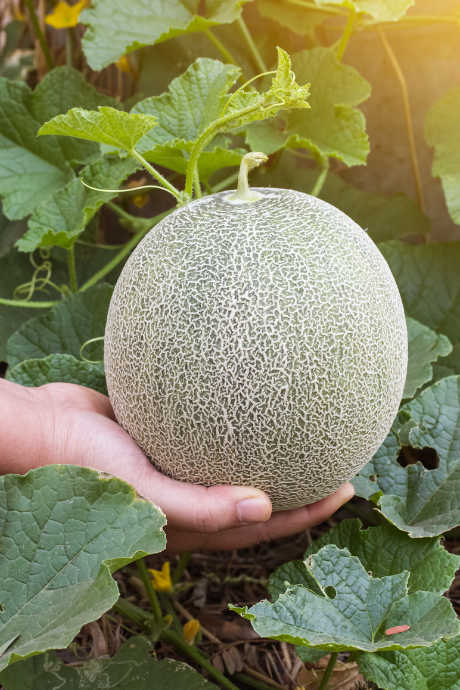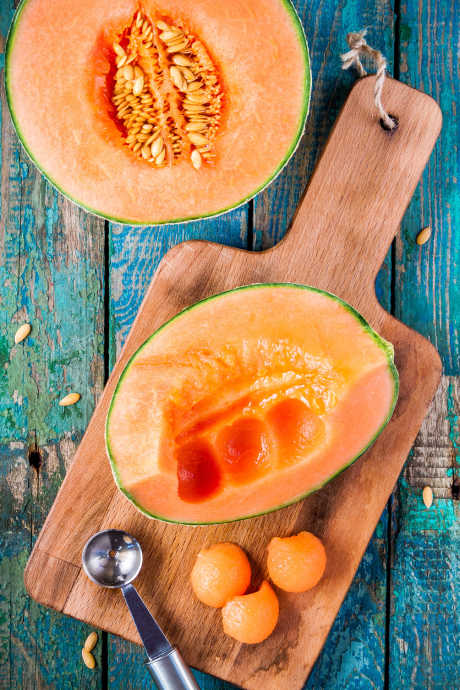Cantaloupe: Vine-Ripened Sweetness
Posted by Julie on May 6th 2020
Summer is on its way, and that means melons will be in season once again. Here in Colorado, we’re fortunate to have excellent weather for growing sweet and juicy cantaloupe. While it’s worth waiting for cantaloupe to be in season, we couldn’t wait to share some helpful tips for selecting and serving these delicious melons.
How to Choose and Cut Cantaloupe
Like other melons and squash, cantaloupe grows on vines. The rind of cantaloupe is thick and rough, with a beige color and a raised web-shaped pattern. The edible flesh inside is orange, with seeds that should be scooped out and discarded. Cantaloupe is a good source of Vitamin C and beta carotene, with a high water content and low in calories.

When selecting cantaloupe, keep these points in mind. Unlike other fruit and vegetables that must be cut off the vine, cantaloupe naturally separates from the vine when it’s ripe. Therefore, look for cantaloupe that has a slight indentation at the stem end, as opposed to one that has a bit of stem still attached. The former was allowed to remain on the vine until ripe, while the latter was cut from the vine prematurely. Gently press that indentation; if it gives slightly, the cantaloupe is ripe. You can let a cantaloupe sit on the counter for a day or two to soften, but it won’t get any sweeter. Finally, give the cantaloupe a sniff; if you can detect sweetness, choose that one.
We recommend the method described by Real Simple for cutting your cantaloupe. In particular, we like the suggestion to cut off the top and bottom of the cantaloupe to create a flat surface and keep the fruit stable as you remove the rind. Use a paring knife to peel away strips of the rind, leaving behind only the orange flesh. If you don’t plan to use the entire cantaloupe, leave the seeds alone on the part you plan to refrigerate. The seeds will help keep the flesh juicy. You can cut your cantaloupe into wedges or cubes, depending on how you plan to serve it.
What to Make With Cantaloupe
Cantaloupe is delicious on its own, as a breakfast or snack. But it’s also a key ingredient in fruit salad and fruit salsa, along with other sweet and savory recipes. We gathered a few ideas we’re looking forward to trying. We hope you’ll give them a shot too.
Black Pepper and Honey Marinated Cantaloupe
This recipe from Saveur sounds like a deliciously unexpected way to dress up cantaloupe for a summer potluck. It’s so simple, there’s no reason not to try it. Crush a couple tablespoons of fresh black peppercorns, and combine them with a half-cup of honey and a cup of boiling water. Once the mixture has cooled, pour it over cantaloupe slices in a serving dish. Cover the dish and refrigerate for several hours or even overnight. Before serving, pour out the excess liquid and sprinkle the cantaloupe with sea salt and fresh basil.
Cantaloupe Gazpacho
We highlighted cold soups in one of our summertime posts, including a watermelon gazpacho. We’re curious to try this cantaloupe gazpacho from Bon Appetit. Surprisingly, this recipe contains no tomatoes. Instead, you’ll puree cantaloupe, cucumber, red onion, salt, and water. Then incorporate olive oil, season with salt and pepper, and garnish with fresh mint. This soup will make a refreshing start to upcoming summer meals.

Grilled Melon and Prosciutto Pasta Salad
We’ve also covered pasta salads and how to make them more appetizing. This recipe from Giada de Laurentiis via Food Network combines crispy fried prosciutto, farfalle pasta, and stovetop-grilled cantaloupe with a homemade mustard vinaigrette. Get out your grill pan and cook entire wedges of cantaloupe until they caramelize. Then dice the cantaloupe to approximately the same size as the pasta. Toss everything with the vinaigrette and serve.
Cantaloupe With Red Wine Syrup
You can even turn cantaloupe into an elegant dessert with this recipe from Fine Cooking. Make a simple syrup of red wine and sugar in a saucepan on the stovetop, and reduce the liquid until a quarter-cup remains. Carefully slice the cantaloupe and scoop out the seeds. Then use a melon baller to create uniform spheres of cantaloupe. Place the cantaloupe balls on dessert plates, and pour the syrup over them.

